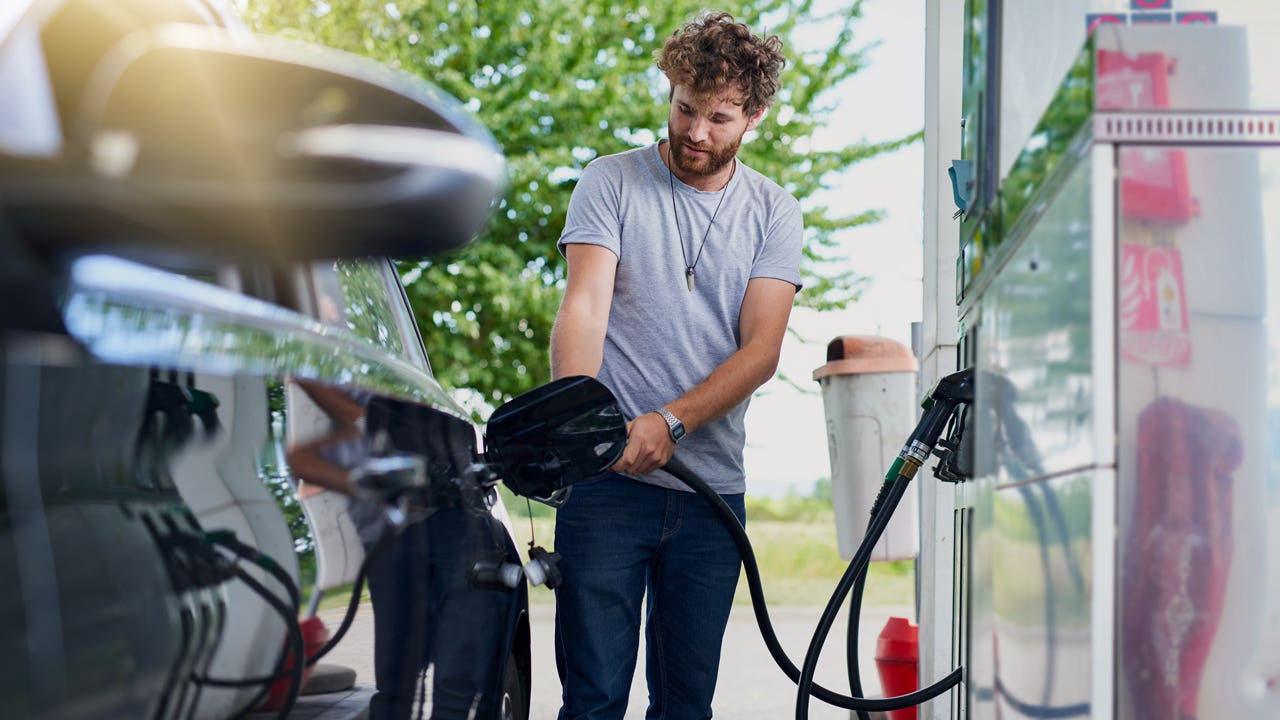How to protect your wallet from scams at the gas pump

The Bankrate promise
At Bankrate we strive to help you make smarter financial decisions. While we adhere to strict , this post may contain references to products from our partners. Here's an explanation for . The content on this page is accurate as of the posting date; however, some of the offers mentioned may have expired. Terms apply to the offers listed on this page. Any opinions, analyses, reviews or recommendations expressed in this article are those of the author’s alone, and have not been reviewed, approved or otherwise endorsed by any card issuer.
If you buy gasoline, then you’ve surely noticed the price of gas has soared since the depths of the pandemic in mid-2020. And with the high price of gas, there has been renewed focus on scams that can take place at the gas pump.
- 15% of Americans surveyed say they’ve been the victim of credit card skimming at a gas pump, and 43% say they’ve changed the way that they pay for gas to avoid skimming, with women and Millennials being more likely to change the way that they pay. (LendingTree)
- Paying for gas inside, instead of at the pump, is the most common way people have changed their payment habits due to the risk of skimming, with 20% reporting doing so. (LendingTree)
- It’s estimated that skimming costs financial institutions and consumers more than $1 billion each year. (FBI)
- In Las Vegas, a single criminal was convicted of using at least 3,120 stolen credit and debit card account numbers, causing a loss of at least $157,695.51. (U.S. Department of Justice)
- The Florida Department of Agriculture and Consumer Services inspects about 9,000 gas pumps each year, and has removed more than 5,500 skimmers since 2015. (FDACS)
- The gasoline industry finds that EMV chips and contactless credit cards are reducing the incidents of skimming. For example, in 2019, 209 skimmers were found in Arizona, but as of March 31, none have been found in 2022. (12news.com)
Credit card skimming
There are many ways that scammers target gas station customers. The most common scam is called skimming, which is when criminals alter a gas pump so that your credit card is read by their device, not the gas station’s. This device skims, or captures, your credit card information, which is quickly used to make fraudulent charges.
How to spot credit card skimming
The skimming device is designed to look like part of the gas pump, but a closer inspection reveals it’s a piece of molded plastic that only appears to be part of the pump’s credit card terminal. Skimmers were first found to be prevalent in cities, but their use has now spread to more rural areas.
To spot a skimmer, pay attention to the credit card terminal, to see if it doesn’t look right in some way. Typically, skimmers are crudely made devices that might look flimsy compared to a legitimate credit card reader. If you try tugging or wiggling the device, and it’s not securely attached to the pump, then there’s a very good chance it’s a skimmer. And if you compare the appearance of the device with those on the other pumps at the gas station, and it’s different, then it’s likely a skimmer, as not every pump will be compromised.
Pump switching
After skimming, one of the most common gas station scams is called pump switching. This is when a criminal switches the hoses from one pump to another. The criminal then waits for someone to pay for gas at that pump, which actually dispenses fuel to the criminal’s car. The criminal will likely use the other pump to dispense a minimal amount of gas in the victim’s car, while filling up his or her own car.
To avoid this scam, double-check that the pump you’re using corresponds with the terminal you’re paying for. And make sure the hose doesn’t wrap around the pump to the other side.
Car robberies
Another crime that occurs at gas stations is the simple car robbery. Victims can have their purses, wallets or other personal items stolen while they’re filling up their tank, or making a purchase at the convenience store. And if you leave your car unattended with the keys in it, the car can be stolen as well. Other crimes include siphoning gas out of a car that’s parked at the convenience store next to a gas station.
To avoid having your car robbed at a gas station, always pay attention to your surroundings. If you see suspicious-looking people loitering around, then you might wish to visit another station, especially at night. Look for a well-lit station with employees and other customers visible. Always remove your keys from your car, and be sure to lock it if you need to use the convenience store or restroom. It’s always a good idea to keep valuables out of sight.
Ways to avoid getting scammed at the gas pump
Although gas pump scams can be clever, there are always ways to avoid them. First, you can simply go inside and pay with cash, if that option is available. Another strategy is to avoid using debit cards at gas stations, because they lack the protections of credit cards.
When your debit card is compromised, the money is instantly removed from your account. But if your credit card has a fraudulent charge, you can dispute it before you need to make a payment. To catch fraudulent charges, always check your credit card statements carefully each month. If you use a debit card with a PIN, be sure to cover the keypad with your hand, to prevent people or even camera’s from learning your PIN.
If you prefer the convenience of paying at the pump, you can try to choose the pump closest to the building. It’s the most visible pump, and the least likely to have a skimmer attached to it, or criminals hanging around it. To be extra safe, always lock your car when you get out, even if you’re standing right next to it, to avoid being the victim of a so-called snatch-and-run thief.
FAQs
-
Look closely at the terminal. Are there gaps between the credit card reader and the rest of the pump? Does it look like it’s home-made? Is it different from other credit card readers at other pumps at that station? You can also grab the reader and try to wiggle it. If it isn’t securely attached to the pump, then it’s almost certainly a skimmer. If you have any doubts, try a different pump or go to a different gas station.
-
If you have excellent credit and a high income, you may be offered a credit line of $30,000 to $50,000. However, it’s possible you may be offered a credit limit that’s higher than that.
-
So-called tap-to-pay readers are contactless payment systems that use radio frequencies to securely transmit your credit card information. If you use a contactless credit card and tap to pay, you can be sure you won’t be the victim of a credit card skimmer.
-
Mastercard and Visa currently require the hold to be less than two hours, but some stations may have longer holds based on the payment network being used. Mastercard and Visa recently raised the limit on their pre-authorization holds on gas purchases from $125 to $175 to account for heftier gas purchases triggered by soaring gas prices. Gas stations and other retailers set their own hold amounts, but Mastercard and Visa set the upper limit.
-
Related Articles


Preventing identity theft: How common it is and how to protect yourself

